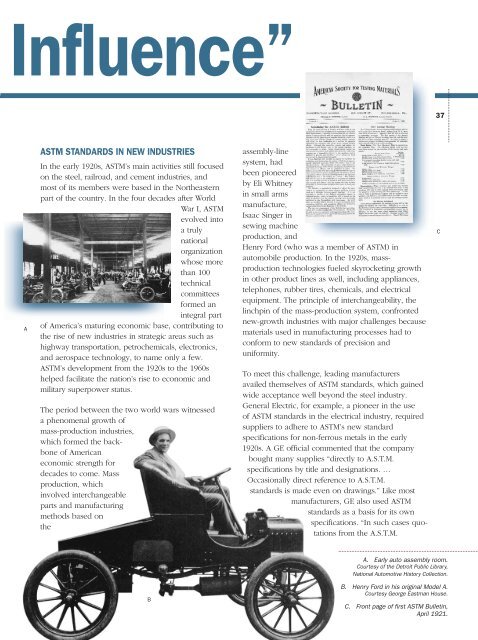ASTM
You also want an ePaper? Increase the reach of your titles
YUMPU automatically turns print PDFs into web optimized ePapers that Google loves.
Influence”<br />
37<br />
A<br />
<strong>ASTM</strong> STANDARDS IN NEW INDUSTRIES<br />
In the early 1920s, <strong>ASTM</strong>’s main activities still focused<br />
on the steel, railroad, and cement industries, and<br />
most of its members were based in the Northeastern<br />
part of the country. In the four decades after World<br />
War I, <strong>ASTM</strong><br />
evolved into<br />
a truly<br />
national<br />
organization<br />
whose more<br />
than 100<br />
technical<br />
committees<br />
formed an<br />
integral part<br />
of America’s maturing economic base, contributing to<br />
the rise of new industries in strategic areas such as<br />
highway transportation, petrochemicals, electronics,<br />
and aerospace technology, to name only a few.<br />
<strong>ASTM</strong>’s development from the 1920s to the 1960s<br />
helped facilitate the nation’s rise to economic and<br />
military superpower status.<br />
The period between the two world wars witnessed<br />
a phenomenal growth of<br />
mass-production industries,<br />
which formed the backbone<br />
of American<br />
economic strength for<br />
decades to come. Mass<br />
production, which<br />
involved interchangeable<br />
parts and manufacturing<br />
methods based on<br />
the<br />
assembly-line<br />
system, had<br />
been pioneered<br />
by Eli Whitney<br />
in small arms<br />
manufacture,<br />
Isaac Singer in<br />
sewing machine<br />
production, and<br />
Henry Ford (who was a member of <strong>ASTM</strong>) in<br />
automobile production. In the 1920s, massproduction<br />
technologies fueled skyrocketing growth<br />
in other product lines as well, including appliances,<br />
telephones, rubber tires, chemicals, and electrical<br />
equipment. The principle of interchangeability, the<br />
linchpin of the mass-production system, confronted<br />
new-growth industries with major challenges because<br />
materials used in manufacturing processes had to<br />
conform to new standards of precision and<br />
uniformity.<br />
To meet this challenge, leading manufacturers<br />
availed themselves of <strong>ASTM</strong> standards, which gained<br />
wide acceptance well beyond the steel industry.<br />
General Electric, for example, a pioneer in the use<br />
of <strong>ASTM</strong> standards in the electrical industry, required<br />
suppliers to adhere to <strong>ASTM</strong>’s new standard<br />
specifications for non-ferrous metals in the early<br />
1920s. A GE official commented that the company<br />
bought many supplies “directly to A.S.T.M.<br />
specifications by title and designations. …<br />
Occasionally direct reference to A.S.T.M.<br />
standards is made even on drawings.” Like most<br />
manufacturers, GE also used <strong>ASTM</strong><br />
standards as a basis for its own<br />
specifications. “In such cases quotations<br />
from the A.S.T.M.<br />
C<br />
A. Early auto assembly room.<br />
Courtesy of the Detroit Public Library,<br />
National Automotive History Collection.<br />
B<br />
B. Henry Ford in his original Model A.<br />
Courtesy George Eastman House.<br />
C. Front page of first <strong>ASTM</strong> Bulletin,<br />
April 1921.




